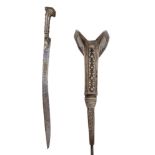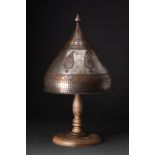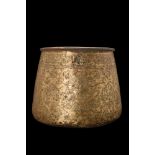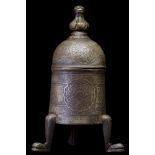Verfeinern Sie Ihre Suche
Schätzpreis
Kategorie
- Arms, Armour & Militaria (147)
- Jewellery (96)
- Islamic Works of Art (67)
- Greek, Roman, Egyptian & Other Antiquities (56)
- Sculpture (51)
- Chinese Works of Art (48)
- Ceramics (45)
- Books & Periodicals (34)
- Salvage & Architectural Antiques (34)
- Glassware (29)
- Collectables (20)
- Porcelain (15)
- Metalware (14)
- Coins (10)
- Vintage Fashion (8)
- Scientific Instruments (7)
- Furniture (6)
- Kitchenalia (6)
- Sporting Memorabilia & Equipment (5)
- Tools (5)
- Lighting (4)
- Russian Works of Art (4)
- Taxidermy & Natural History (4)
- Clocks (3)
- Musical Instruments & Memorabilia (2)
- Textiles (2)
- Cameras & Camera Equipment (1)
- Classic Cars, Motorcycles & Automobilia (1)
- Entertainment Memorabilia (1)
- Ethnographica & Tribal Art (1)
- Indian Works of Art (1)
- Models, Toys, Dolls & Games (1)
- Oil, Acrylic paintings & Mixed Media (1)
- Silver & Silver-plated items (1)
- Writing Instruments (1)
- Liste
- Galerie
Ein Abonnement der Preisliste ist notwendig um Ergebnisse, von Auktionen die vor einem längeren Zeitraum als 10 Tagen stattgefunden haben, ansehen zu können. Klicken Sie hier für mehr Informationen
MEDIEVAL IRON WAR HAMMER
Ca. 1300 AD. A war hammer forged from iron with a slender body, a tapered handle meant to accommodate a leather wrap, and a conical shaped finial....
MEDIEVAL IRON AXE HEAD
Ca. 1200-1500 AD.An iron axehead with a curved blade that features two pointed tips, a central socket, and a hammer at the rear. The curvature of ...
Ca. 1800 AD. Brass hilt with D-shaped guard with ribbed handle, the guard has stamped with inspection marks "P" and "D", curved single-edged blade...
Ca. 1840 AD. An original sidearm, model 1840, "Faschinenmesser: it is a pioneer artillery short sword regimentally marked and a crown over JR (for...
Ca. 1813 AD. A scarce 1747 Prussian model/1813 Danish model, heavy cavalry backsword, Napoleonic wars. "Rytterpallask M1813" for a heavy dragoon c...
Ca. 1025-1380 AD. A stunning iron sword Oakshott type ‘G’, with a wide blade almost parallel, then tapers down to a sharpish point. The blade is d...
Ca. 1300-1500 AD. An iron double-edged dagger with a straight sculptured cross guard with incised decoration and tapering tang to the disc-shaped ...
Ca. 13th-15th century AD. A short iron dagger with a broad blade tapering to a point. The cross guard straight, and a hilt finished with a scent b...
Ca. 13th-15th century AD. A long iron dagger with a slender blade tapering to a point, a short cross guard, and an off-square pommel. The pommel h...
Ca. 14th-15th century AD. An iron stiletto dagger with a diamond shape in section blade, circular cross guard, and a slim tang finished with a cir...
Ca.late 19th century AD. Gilt brass knight-helmet-shaped pommel and cross guard featuring an American Eagle, ebony grip with an inserted brass cro...
Ca.late 19th century AD. A pair of antique American Masonic Knights Templar ceremonial swords with stainless steel blades. One has a wire-wrapped ...
Ca.late 19th century AD. An antique American Knights of Pythias ceremonial sword with a single-edged blade decorated with etched floral motifs, F....
Ca. the mid-late 19th century AD. A pair of antique American Masonic Knights Templar ceremonial swords with etched decorated blades. One holds the...
Ca.late 19th century AD. Brass knight-helmet-shaped pommel and cross guard featuring a Knights Templar Sherwood Forest (KSF) monogram, wood grip w...
Ca. 1837 AD. Brass hilt with a D-shaped guard and ribbed handle, the guard is stamped with inspection marks "D" "PDL" and "L", and stamped date on...
Ca. 1425-1450 AD. An excellent forged-iron long sword with a broad blade tapering to a sharp point. The cross guard is of a ‘tommy bar’ type. The ...
Ca. 1425-1550 AD. An iron sword Oakshott type ‘G1’ of a double-edged bevelled and pointed blade with shallow groove, straight cross guard, and int...
SCYTHIAN IRON ACINACES SWORD
Ca. 500-400 BC. An iron acinaces-type sword with long, broad tapering blade, which terminates in a point, rectangular grip with lobed lower guard,...
VIKING IRON SEAX BLADE
Ca. 900-1000 AD. An iron seax blade with a straight cutting edge and sharply angled back, the tang offset from the blade. Its hilt would have been...
VIKING IRON KNIFE BLADE
Ca. 900-1000 AD. An iron seax blade with a straight cutting edge and sharply angled back, the tang offset from the blade. Its hilt would have been...
Ca. 13th-15th century AD. An iron short sword featuring a slender blade tapering to a point, with an acutely bent cross guard and a tang ended in ...
Ca. 13th-15th century AD. An iron short knife blade with rivetted tang and integral forged round pommel. The tang may have been inlaid with wood o...
Ca. 10th-11th century AD. An iron seax blade with a straight cutting edge and angled back, the tang offset from the blade. Its hilt would have bee...
Ca. 1866 AD. A French Chassepot rifle bayonet Mod.1866. The bayonet has a “yataghan” blade. The hilt is ribbed brass, and the sheath is steel. The...
Ca. 19th century AD. Brass hilt, D-shaped cast-bronze knuckle guard and ribbed handle, single-edged blade with one fuller on either side, no scabb...
Ca. 1650 AD. An iconic cutlass barbary pirate short sword, mounted with an early 17th-century European blade with the markings from Italy. remount...
MEDIEVAL IRON SWORD
Ca. 1250-1520 AD. This fine Medieval sword features a pommel of an unusual design. It is circular when viewed from the front and sides, but displa...
LATE MEDIEVAL IRON DAGGER
Ca. 14th-15th Century AD. A poniard with iron, disc like fittings that have scalloped edges. The blade is long and thin, much of the same proporti...
MEDIEVAL IRON KNIFE/DAGGER
Ca. 13th-15th century AD. An iron dagger with sleek single-edged blade exudes elegance and simplicity, while the straight cross guard and curved t...
MEDIEVAL IRON DAGGER
Ca. 14th-15th century AD. An iron dagger of exceptional craftsmanship and beauty. The slender blade tapered to a fine point, speaks of its purpose...
Ca. 1000-1100 AD. The broad blade flaring to the curved cutting edge, with an eared socket with a D-shaped aperture. Commonly referred to as the D...
SCYTHIAN IRON ACINACES SWORD
Ca. 500-400 BC. An iron sword with a broad tapering blade, which terminates in a point, rectangular grip with a lobed lower guard, crescentic pomm...
Ca. 900-1200 AD. A hefty, mold-formed pottery hand grenade with a piriform body, a rounded shoulder, and a narrow mouth. The exterior body is deco...
Ca. 800-1000 AD. An acorn-shaped ceramic vessel with a tapered base and broad top with a small spout which probably would have been filled with ex...
Ca. 800-1000 AD. A ceramic hollow vessel featuring a bi-conical body that tapers to a pointed base, and to the other end it finishes with a spout ...
Ca. 800-1000 AD. A ceramic grenade also referred to as 'Greek Fire'. This hollow ceramic vessel consists of a piriform body, with a short neck and...
Ca. 1889 AD. Rare Prussian Wurttenburg Model 1889 infantry officer’s sword with brass hilt and folding guard in the form of the Wurttemberg coat o...
Ca. 1915 AD. One of the variations of the Lionhead sword – the "Jawless" or "Half-lion head" where the lion has no lower jaw. Brass hilt with some...
Ca. 1915 AD. One of the variations of the Lionhead sword is the "Jawless" or "Half-lion head" where the lion has no lower jaw. Brass D-guard hilt ...
A LARGE KRIS DAGGER
Indonesia, ca. 19th-20th century AD. A kris dagger with an elegant and distinctive blade-patterning achieved through alternating laminations of ir...
INDIAN GOURD GUN POWDER VESSEL
Ca. 19th century AD. A gourd-shaped vessel with a squat, bulbous lower body and a curvaceous stem rising from the top. The body of the vessel, apa...
Ca. late 19th – early 20th cc. AD. A matching set consisting of a ceremonial Indo-Perislan etched and engraved steel shield and helmet with chain ...
Ca. 19th century AD. Hilt and scabbard fittings are richly decorated with silver bands, rosettes, and chiseling, the scabbard is covered with leat...
Ca. late 18th century AD. A pair of stirrups either from Turkey or North Africa, decorated with gold inlay and turquoise. Condition: Very good wit...
Ca. 19th century AD. With a characteristic form eared silver hilt decorated with repousse and engraving, recurved single-edged blade with gold inl...
SAFAVID STEEL HELMET
Ca. 17th century AD. This steel helmet is a masterpiece of craftsmanship and elegance, a true testament to the artistry of its makers. Its conical...
Ca. EARLY 14th century AD. A candlestick with a balustered body and a mouth delicately shaped like a flower bud. Every section of this piece, from...
Ca. early 14th century AD. A bronze plate of a shallow form features a circular recess in the center, which is adorned with a striking silver-inla...
Safavid or Mughul period, ca. 17th century AD. A large copper tray with a stand, intricately decorated. The plate of shallow and wide form, with a...
LARGE BRONZE DOORKNOB
Safavid / Mughal, 1604 AD. A doorknob plate featuring a domed shape that is both imposing and elegant, with a flat flange that adds an element of ...
Ca. 17th century AD. A stonepaste vase with its bulbous lower body and elegant funnel-shaped neck. The intricate decoration of this vase is truly ...
SELJUK DECORATED LEAD FLASK
Ca. 13th century AD. A flask of inverted piriform shape, with its gradual tapering towards the cylindrical neck and delicate tulip-shaped mouth. B...
INDIAN BRASS ASTROLABE
India, ca. 18th-19th century AD. An astrolabe, the instrument of a circular frame, with a flaring finial and piercing at the top and at the centre...
ISLAMIC INCENSE BURNER
Ca. 17th-19th century AD. An incense burner with its balustered body and splayed circular foot exudes an aura of opulence and grandeur. The flarin...
TIMURID BRASS POT
Ca. 14th century AD. A brass vessel featuring a round base with walls that gently taper to the opening, which is adorned with a rounded rim. The e...
TIMURID BRONZE TEAPOT
Ca. 14th century AD. A bronze teapot with a bulbous lower body, nicely decorated with vertical ribs that add texture and visual interest. The tubu...
OTTOMAN PAIR OF GOLD EARRINGS
Ca. late 19th century AD. A pair of gold earrings with graceful curves of the hooks and loops draw the eye down to the teardrop-shaped pendants, w...
Ca. Late 19th to 20th century AD. A brass incense burner of a wide tubular body richly decorated with silver inlays, resting on three feet with st...
SELJUK EWER
Ca. 1100-1200 AD. This Seljuk brass ewer is a remarkable piece of craftsmanship, adorned with intricate details that attest to the artisan's excep...





























































